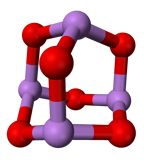ASH: Non-Chemo Regimen ‘Not Inferior’ in Newly Diagnosed APL
A combination of all-trans retinoic acid (ATRA) and arsenic trioxide resulted in outcomes “at least not inferior” to those achieved when ATRA was used in combination with idarubicin chemotherapy in newly diagnosed patients with non–high-risk, acute promyelocytic leukemia.
A combination of all-trans retinoic acid (ATRA) and arsenic trioxide resulted in outcomes “at least not inferior” to those achieved when ATRA was used in combination with idarubicin chemotherapy in newly diagnosed patients with non–high-risk, acute promyelocytic leukemia (APL). Findings of the phase III, prospective, randomized, intergroup study, conducted at 67 centers in Germany and Italy, were reported by Francesco Lo-Coco, MD, of the University of Tor Vergata, Rome.

Ball-and-stick model of arsenic trioxide
Simultaneous ATRA and chemotherapy is the current “gold standard” for newly diagnosed APL resulting in roughly 80% cure rates, while arsenic trioxide is the current treatment of choice for relapsed patients, Dr. Lo-Coco said. Arsenic trioxide in variable combinations with and without ATRA or chemotherapy has also been investigated as frontline therapy, yielding encouraging results in several pilot studies and in two phase III studies conducted in China and the United States. This is the first randomized study to compare frontline the chemotherapy-free arsenic trioxide plus ATRA combination against the standard ATRA plus chemotherapy.
Patients who were randomly assigned to receive noncytotoxic treatment (n = 79) received arsenic trioxide 0.15/kg plus ATRA 45 mg/m2 twice daily until complete response, and then arsenic trioxide for 5 days per week, 4 weeks on and 4 weeks off, for a total of four courses, and ATRA, 2 weeks on and 2 weeks off, for a total of seven courses.
Patients in the control arm (n = 80) received standard ATRA plus idarubicin induction, followed by three cycles of anthracycline-based plus ATRA consolidation, followed by ATRA and low-dose chemotherapy for maintenance.
The primary objective of the study was event-free survival at 2 years, and the study was designed to show that the rate of patients alive event-free at 2 years in the experimental treatment arm is at least 80%.
Results were similar for the two treatment arms. After a median follow-up of 31 months, 2-year event-free survival was 97% in the ATRA plus arsenic trioxide treatment arm and 87% in the ATRA plus chemotherapy arm. Overall survival was 98.7% and 91.1%, respectively.
Adverse events, including fever episodes, prolonged neutropenia and thrombocytopenia were significantly more frequent in the ATRA plus chemotherapy arm, said Dr. Lo-Coco. A higher incidence of QT prolongation as well as hepatotoxicity and leukocytosis were observed in the ATRA plus arsenic trioxide arm. These side effects, however, were manageable.
The results, said Dr. Lo-Coco, represent “the demolition of a dogma” because they show it is possible to transform malignant cancer cells instead of killing them with chemotherapy and that "cancer is not an irreversible condition.”
“This is an exciting development, because it is a shift in the way we think of treating potentially fatal diseases,” commented ASH president Armand Keating, MD, director of hematology at the University of Toronto, Canada.
“I found this study amazing,” added Charles Abrams, MD, of the hematology/oncology division at the University of Pennsylvania, Philadelphia. “APL used to be the worst among the worst” of hematologic malignancies. “Now we see for the first time that it can be treated by nonchemotherapy.”